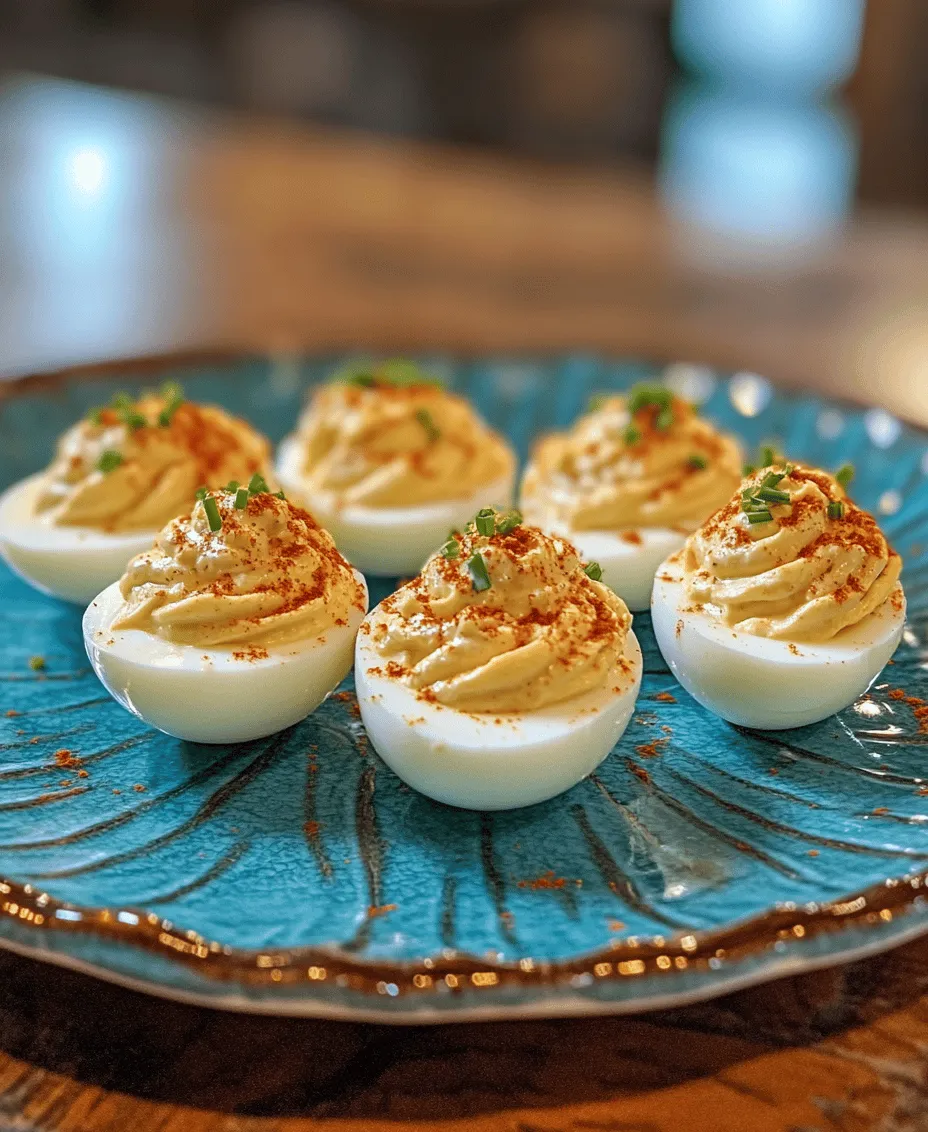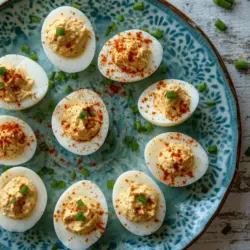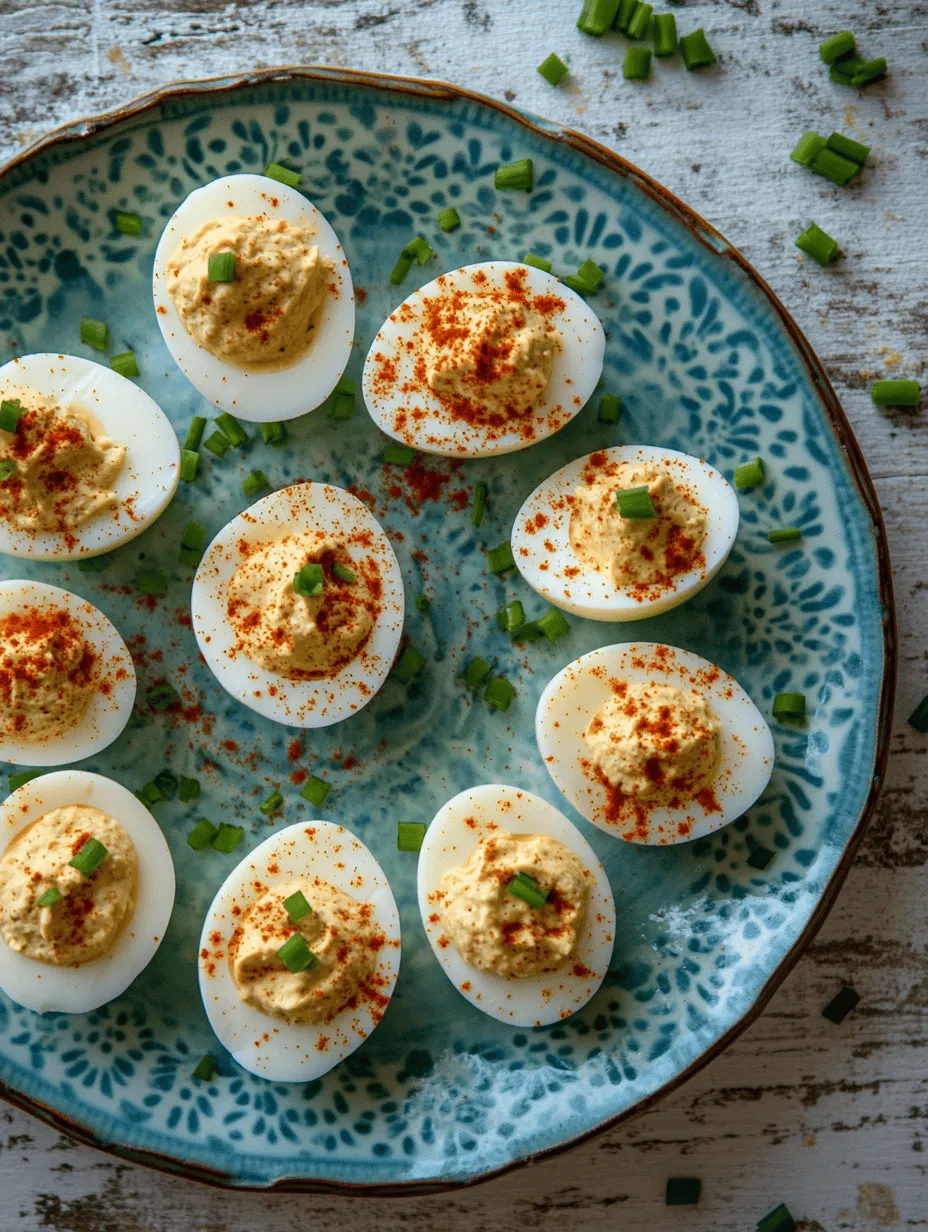Introduction
Deviled eggs have long held a cherished place in the world of appetizers, known for their creamy filling and vibrant presentation. This classic dish, often seen at family gatherings, picnics, and holiday celebrations, is not only delicious but also remarkably versatile. The appeal of deviled eggs lies in their simplicity, making them an excellent choice for both casual get-togethers and formal events. As a timeless recipe, deviled eggs delight the palate while offering an inviting visual appeal that makes them a favorite among hosts and guests alike.
Historically, deviled eggs can be traced back to ancient times, with variations appearing in diverse cuisines across the globe. The term “deviled” emerged in the 18th century, referring to the spicy and zesty flavors associated with the dish. Today, they remain a staple in American potlucks and parties, embodying a sense of nostalgia and comfort that resonates with many. The ease of preparation and the ability to customize flavors make homemade deviled eggs a popular choice for anyone looking to impress their guests with minimal effort.
Understanding Deviled Eggs
To fully appreciate the allure of deviled eggs, it’s essential to understand their definition and origin. Simply put, deviled eggs are hard-boiled eggs that have been halved and filled with a creamy mixture made primarily from the yolks. The basic components of the filling typically include mayonnaise, mustard, and various seasonings, but this foundational recipe allows for endless creativity.
Deviled eggs have taken on various forms worldwide, showcasing regional flavors and ingredients. For example, in Germany, deviled eggs might be garnished with crispy bacon, while in the Mediterranean, one could find them enriched with olives and herbs. These cultural variations highlight the adaptability of deviled eggs, allowing them to fit seamlessly into any culinary tradition. Regardless of the version, they remain a beloved dish that brings people together, embodying the spirit of communal dining.
The enduring popularity of deviled eggs can be attributed to several factors. First, their creamy, rich texture provides a delightful contrast to the firm whites, creating a harmonious balance. Moreover, they are easy to prepare, making them an accessible option for cooks of all skill levels. The potential for customization further enhances their appeal, allowing home chefs to experiment with flavors and presentation. Whether you prefer classic flavors or bold, innovative twists, deviled eggs can cater to diverse tastes and preferences.
Ingredients Breakdown
Now that we’ve established the significance of deviled eggs, let’s delve into the essential ingredients that form the backbone of the Classic Deviled Eggs Delight recipe. Each component plays a crucial role in achieving the perfect flavor and texture.
Large Eggs
The most critical ingredient in deviled eggs is, of course, the eggs themselves. When selecting eggs, freshness and quality should be your primary considerations. Fresh eggs make for firmer whites and richer yolks, resulting in a better overall texture. When possible, choose organic or free-range eggs, as they often have superior flavor and quality. The size of the eggs can also impact the final product; large eggs are typically recommended for this recipe to ensure adequate filling.
Mayonnaise
Mayonnaise is the creamy foundation of the deviled egg filling, contributing richness and moisture. When it comes to selecting the right mayonnaise, personal preference plays a significant role. Some may prefer the classic flavor of store-bought mayonnaise, while others might opt for homemade versions that can provide a fresher taste. For those looking to reduce calories, light mayonnaise or Greek yogurt can serve as excellent substitutes without compromising too much on flavor.
Dijon Mustard
Dijon mustard adds a tangy kick to the filling, enhancing the overall taste of deviled eggs. This ingredient is essential for balancing the creaminess of the mayonnaise and yolks. The subtle heat and depth of flavor provided by Dijon mustard elevate deviled eggs from ordinary to extraordinary. For a milder flavor, yellow mustard can be used, but for a more sophisticated profile, Dijon is the preferred choice.
White Vinegar
Adding a splash of white vinegar to the filling not only contributes acidity but also helps to balance the flavors. Vinegar cuts through the richness of the mayonnaise and yolk mixture, creating a well-rounded taste. Additionally, vinegar can be used during the boiling process to aid in peeling by helping to firm up the egg whites, making them easier to remove from the shell.
Seasoning
Salt and pepper are essential for elevating the flavors of deviled eggs. A pinch of salt enhances the natural taste of the ingredients, while pepper adds a subtle warmth. It’s important to taste as you go, adjusting the seasoning to suit your personal preferences. Some may choose to integrate other spices or seasonings, such as paprika or cayenne pepper, for an extra layer of flavor.
Optional Garnishes and Variations
While the classic recipe provides a delicious base, the true beauty of deviled eggs lies in their versatility. Many home cooks enjoy experimenting with garnishes and variations to create unique presentations. Some popular options include:
- Paprika: A classic garnish, paprika adds color and a mild smoky flavor.
- Chives or Green Onions: Fresh herbs provide a delightful crunch and vibrant color.
- Bacon Bits: Crispy bacon adds a savory, salty contrast to the creamy filling.
- Olives: Chopped olives can introduce a briny flavor that pairs well with the other ingredients.
- Hot Sauce: For those who enjoy a bit of heat, a few dashes of hot sauce can elevate the dish.
These optional ingredients allow you to customize your deviled eggs to your liking, ensuring they stand out at any gathering.
Step-by-Step Preparation Guide
With the ingredients laid out, it’s time to dive into the step-by-step preparation guide for making Classic Deviled Eggs Delight. Following these instructions will help you achieve the perfect hard-boiled eggs and a creamy filling that will impress your guests.
Preparing the Eggs: Cooking Techniques for Perfect Hard-Boiled Eggs
The first step in creating deviled eggs is to cook the eggs to perfection. There are several methods to achieve hard-boiled eggs, but two of the most popular techniques are stovetop boiling and using an Instant Pot.
Stovetop Method:
1. Place the desired number of eggs in a single layer in a saucepan.
2. Fill the pot with cold water, ensuring that the eggs are covered by at least an inch of water.
3. Bring the water to a rolling boil over medium-high heat.
4. Once boiling, cover the pot with a lid and remove it from heat.
5. Let the eggs sit for 9-12 minutes, depending on the desired firmness (9 minutes for a softer yolk, 12 for a firmer yolk).
Instant Pot Method:
1. Place a steamer basket inside the Instant Pot and add 1 cup of water.
2. Arrange the eggs on the steamer basket.
3. Close the lid and set the Instant Pot to high pressure for 5 minutes.
4. Once the timer goes off, manually release the pressure and transfer the eggs to an ice bath for 5-10 minutes.
Cooling and Peeling: Tips for Easy Peeling of Eggs
After cooking, it’s essential to cool the eggs quickly to stop the cooking process and make peeling easier. The ice bath method is highly effective:
1. Fill a large bowl with ice water.
2. Once the eggs are done cooking, transfer them immediately to the ice bath.
3. Let them sit for at least 5 minutes to cool completely.
4. To peel, gently tap the egg on a hard surface to create cracks, and then roll it between your hands to loosen the shell. Start peeling from the wider end, where there is usually an air pocket, which makes it easier to remove the shell.
Making the Filling: Combining Ingredients for a Creamy Texture
Once the eggs are cooled and peeled, it’s time to prepare the filling. Here’s how to do it:
1. Carefully slice each egg in half lengthwise and gently remove the yolks, placing them in a mixing bowl.
2. Mash the yolks with a fork until they reach a smooth consistency.
3. Add the mayonnaise, Dijon mustard, white vinegar, salt, and pepper to the bowl. Adjust the amounts according to your taste preferences.
4. Mix these ingredients until they are well combined and creamy. You can use a hand mixer or food processor for a smoother texture.
Mixing Techniques for Even Distribution of Flavors
To ensure that the flavors are evenly distributed throughout the filling, consider these mixing techniques:
- Hand Mixing: For those who prefer a chunkier texture, mixing by hand allows for some egg yolk pieces to remain, adding a bit of character to the filling.
- Food Processor: If you want an ultra-smooth filling, a food processor can achieve a creamy consistency in seconds. Just be careful not to over-process, as this can turn the filling too runny.
Adjusting Flavors: How to Customize to Personal Taste
As you prepare your filling, remember that this is your opportunity to customize the flavor profile to suit your taste. Here are a few ideas to enhance your deviled eggs:
- For a bit of zest, consider adding a teaspoon of lemon juice or a pinch of zest.
- If you enjoy a touch of sweetness, a dash of sugar or sweet pickle relish can balance the flavors beautifully.
- Experiment with different spices such as garlic powder, onion powder, or smoked paprika to create a unique flavor combination.
With these foundational steps, you are well on your way to creating Classic Deviled Eggs Delight that will tantalize the taste buds of your family and friends. Whether you stick to the traditional recipe or venture into exciting variations, these deviled eggs are sure to be a hit at your next gathering.

Plating and Presentation
When it comes to serving Classic Deviled Eggs, presentation is key to making them appealing and enticing for guests. Whether you’re hosting a sophisticated dinner party or a casual picnic, the way you plate your deviled eggs can elevate the dining experience. Here are some creative serving ideas, garnishing options, and themed presentations that can transform your deviled eggs from simple bites into a stunning centerpiece.
Creative Serving Ideas for Deviled Eggs
Traditional deviled eggs are typically served on a platter or egg tray, but there are many modern twists you can incorporate. Consider using an elegant tiered stand to showcase your deviled eggs at gatherings. This not only saves space but also allows guests to admire the colorful filling. You can also serve them in individual cups or on a bed of greens, such as arugula or microgreens, to add a fresh touch.
Another popular trend is to create a deviled egg bar. Set out a variety of toppings and mix-ins, allowing guests to customize their eggs. Toppings may include crispy bacon, pickled jalapeños, dill pickle relish, and various spices. This interactive approach is sure to be a hit at any gathering.
Traditional Serving Styles Versus Modern Twists
While traditional serving styles remain timeless, modern presentations can add flair to your dish. For a classic look, use a simple white platter or a colorful ceramic dish that complements the filling. For a more contemporary approach, consider serving them in mason jars or on slate boards. This not only adds an aesthetic appeal but also provides a rustic charm.
Garnishing Options: Paprika, Chives, and More
Garnishing your deviled eggs enhances not only the visual appeal but also the flavor. The classic sprinkle of smoked paprika is always a hit, adding a subtle smokiness and a pop of color. Freshly chopped chives or dill can provide a hint of herbal freshness. For a bolder presentation, consider using edible flowers or microgreens. These options not only look beautiful but also add unique flavors that can elevate your dish.
Suggestions for Themed Presentations
Themed presentations can make your deviled eggs even more special for holiday gatherings or events. For Easter, consider using pastel-colored eggs and garnishing with herbs to reflect a springtime vibe. For Halloween, use food coloring to create striking black or orange fillings, garnished with spooky-themed decorations. At summer picnics, serve deviled eggs on a vibrant picnic blanket with fresh fruits and vegetables for a colorful spread. These themed presentations not only enhance the visual appeal but also create memorable experiences for your guests.
Nutritional Information
Deviled eggs are not only delicious but also packed with nutritional benefits. Understanding their nutritional profile can help you appreciate their role in a balanced diet.
Overview of the Nutritional Benefits of Deviled Eggs
Eggs are a powerhouse of nutrition, containing essential vitamins and minerals. A typical deviled egg made with a whole egg and traditional filling contains protein, healthy fats, and various vitamins such as B12, D, and A. These nutrients contribute to overall health, making deviled eggs a satisfying option for any meal.
Protein Content and Benefits of Eggs in the Diet
One large egg contains about 6 grams of protein, making deviled eggs an excellent source of this macronutrient. Protein is essential for muscle repair and growth, making deviled eggs a great post-workout snack. Additionally, the protein in eggs can help you feel fuller for longer, which is beneficial for those looking to manage their weight.
Caloric Breakdown and Considerations for Dietary Restrictions
A standard deviled egg typically contains around 70 calories, depending on the filling and additional ingredients used. While they are relatively low in calories, it’s essential to consider dietary restrictions. For those watching their cholesterol intake, using only egg whites can significantly reduce cholesterol levels while still providing a delicious experience.
Healthier Alternatives: Low-Fat Mayonnaise and Vegan Options
To make deviled eggs healthier, consider substituting low-fat mayonnaise or Greek yogurt for traditional mayonnaise. These substitutions reduce calories and fat while adding a creamy texture. For vegan options, you can create a filling using avocado, hummus, or silken tofu blended with spices. This way, you can enjoy the classic taste without the cholesterol and animal products.
Pairing Suggestions
Pairing your deviled eggs with the right beverages and complementary dishes can enhance the overall dining experience.
Best Beverages to Complement Deviled Eggs
When it comes to beverages, deviled eggs pair well with a variety of drinks. For those who enjoy wine, white wines such as Sauvignon Blanc or Chardonnay enhance the creamy flavors of the eggs. If you’re serving a more casual gathering, consider offering sparkling options like Prosecco or Champagne, which add a celebratory touch.
Non-Alcoholic Options: Refreshing Drinks That Enhance Flavor
If you prefer non-alcoholic options, refreshing drinks like lemonade, iced tea, or sparkling water with fresh fruit can elevate the meal while cleansing the palate between bites. Consider offering a fruity mocktail with mint and citrus to complement the richness of the deviled eggs.
Complementary Dishes to Serve Alongside Deviled Eggs
Deviled eggs are versatile and can be served as appetizers or alongside other dishes. They pair wonderfully with light salads, such as a cucumber salad or a classic Caesar salad, which provide a refreshing contrast to the richness of the eggs. For a more substantial meal, consider adding a charcuterie board with a variety of cheeses, meats, and crackers, or serving them alongside other appetizers like stuffed mushrooms or bruschetta.
Cultural Significance and Fun Facts
Deviled eggs have a rich cultural significance and interesting history that spans centuries, making them a beloved dish in many households.
The Role of Deviled Eggs in Different Cultures and Celebrations
Deviled eggs are popular in various cultures, often appearing at holiday gatherings, potlucks, and family reunions. In the United States, they are a staple at Easter celebrations, symbolizing new life and rebirth. In other cultures, variations of deviled eggs can be found, such as the Spanish “huevos rellenos” or the Italian “uova farcite,” showcasing the versatility of this dish.
Interesting Trivia About Deviled Eggs Throughout History
The term “deviled” dates back to the 18th century and originally referred to dishes that contained spicy ingredients. Over time, deviled eggs have evolved into the creamy, flavorful bites we know today. Interestingly, the first known recipe for deviled eggs appeared in ancient Rome, highlighting their long-standing appeal.
Famous Deviled Egg Recipes from Renowned Chefs
Many renowned chefs have put their unique spins on deviled eggs, showcasing their creativity and versatility. For example, chef Thomas Keller offers a sophisticated version using truffle oil, while chef Ina Garten incorporates mustard and dill for a refreshing twist. Exploring these variations can inspire you to create your own signature deviled egg recipe.
Conclusion
Classic Deviled Eggs have stood the test of time, remaining a favorite appetizer for gatherings and celebrations. Their simplicity, elegance, and versatility make them a staple in many kitchens. As you explore this delightful dish, consider experimenting with variations, garnishes, and presentations to make them your own.
Whether you are preparing them for a festive occasion or a casual get-together, deviled eggs are sure to please. Embrace the opportunity to create a memorable experience for your guests and enjoy the deliciousness of this beloved dish. With their rich history, cultural significance, and endless possibilities for customization, deviled eggs will continue to hold a cherished place at tables around the world.


